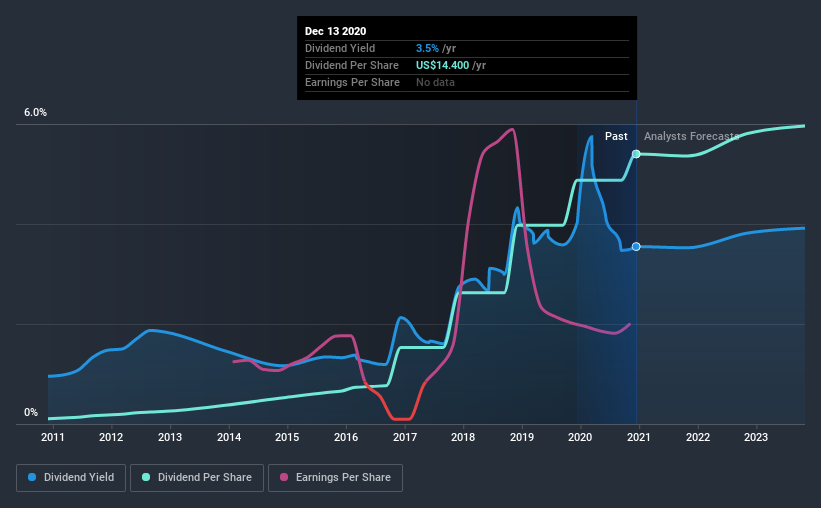Regular readers will know that we love our dividends at Simply Wall St, which is why it's exciting to see Broadcom Inc. (NASDAQ:AVGO) is about to trade ex-dividend in the next 3 days. This means that investors who purchase shares on or after the 18th of December will not receive the dividend, which will be paid on the 31st of December.
Broadcom's next dividend payment will be US$3.60 per share, and in the last 12 months, the company paid a total of US$14.40 per share. Based on the last year's worth of payments, Broadcom has a trailing yield of 3.5% on the current stock price of $405.82. Dividends are an important source of income to many shareholders, but the health of the business is crucial to maintaining those dividends. So we need to investigate whether Broadcom can afford its dividend, and if the dividend could grow.
If a company pays out more in dividends than it earned, then the dividend might become unsustainable - hardly an ideal situation. An unusually high payout ratio of 201% of its profit suggests something is happening other than the usual distribution of profits to shareholders. Yet cash flow is typically more important than profit for assessing dividend sustainability, so we should always check if the company generated enough cash to afford its dividend. It distributed 48% of its free cash flow as dividends, a comfortable payout level for most companies.
It's disappointing to see that the dividend was not covered by profits, but cash is more important from a dividend sustainability perspective, and Broadcom fortunately did generate enough cash to fund its dividend. If executives were to continue paying more in dividends than the company reported in profits, we'd view this as a warning sign. Very few companies are able to sustainably pay dividends larger than their reported earnings.
Click here to see the company's payout ratio, plus analyst estimates of its future dividends.

Have Earnings And Dividends Been Growing?
Stocks in companies that generate sustainable earnings growth often make the best dividend prospects, as it is easier to lift the dividend when earnings are rising. If earnings decline and the company is forced to cut its dividend, investors could watch the value of their investment go up in smoke. This is why it's a relief to see Broadcom earnings per share are up 4.7% per annum over the last five years.
Many investors will assess a company's dividend performance by evaluating how much the dividend payments have changed over time. In the last 10 years, Broadcom has lifted its dividend by approximately 48% a year on average. It's encouraging to see the company lifting dividends while earnings are growing, suggesting at least some corporate interest in rewarding shareholders.
To Sum It Up
Is Broadcom an attractive dividend stock, or better left on the shelf? Broadcom has been slowly growing its earnings per share, and it has interesting dividend payout behaviour that we think is worth highlighting. Specifically, it's paying out just 48% of its cash flow but a huge 201% of its income. This is a interesting combination, but the high payout ratio is a definite concern. While it does have some good things going for it, we're a bit ambivalent and it would take more to convince us of Broadcom's dividend merits.
With that being said, if dividends aren't your biggest concern with Broadcom, you should know about the other risks facing this business. We've identified 3 warning signs with Broadcom (at least 1 which is significant), and understanding them should be part of your investment process.
A common investment mistake is buying the first interesting stock you see. Here you can find a list of promising dividend stocks with a greater than 2% yield and an upcoming dividend.
This article by Simply Wall St is general in nature. It does not constitute a recommendation to buy or sell any stock, and does not take account of your objectives, or your financial situation. We aim to bring you long-term focused analysis driven by fundamental data. Note that our analysis may not factor in the latest price-sensitive company announcements or qualitative material. Simply Wall St has no position in any stocks mentioned.
Have feedback on this article? Concerned about the content? Get in touch with us directly. Alternatively, email editorial-team@simplywallst.com.
The views and opinions expressed herein are the views and opinions of the author and do not necessarily reflect those of Nasdaq, Inc.


